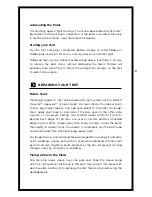
The Frontenac has a number of guyline attachments so you can rig
it increasingly securely in response to actual or anticipated winds.
To secure the tent:
1
Guy out the four main corners of the tent using the attachment points
that are about halfway up each corner of the fly. These lines should run
out at about a 45-degree angle from the tent, that is, in about the same
direction as each pole is “pointing.”
2
Guy out the tab from the front door window.
3
Guy out the bottom hem of the front door main panel.
4
Guy out the two tabs at the very top of the tent roof. These guylines
should run out at ninety degrees to the tent sides.
5
Guy out the tab from the roof vent; this will be most secure if the vent
is shut with the hook-and-loop patches.
Only extreme conditions require the use of all guyline points. To save
weight and cost for the average user, the tent is not supplied with pegs
and lines for all points.
Anchoring the Tent
The #7001-T6 aluminum stakes included with the tent are suitable for
general use on relatively soft ground. However, in very hard-packed
ground you will need stronger (and heavier!) stakes that can withstand
the force needed to drive them in. On snow, sand, or other loose-packed
surfaces, wider T-Stakes or aluminum snow stakes will hold better; these
stakes hold best buried horizontally. You can also improvise with other
“stakes” (hiking staffs, ice axes, branches, rocks, trees), using the tent’s
stake loops or cord as required.
When packing for your trip, consider the conditions you’ll likely encounter
and what sort of anchors you’ll require. You can often leave several of
the supplied pegs at home and replace them with improvised anchors,
thereby saving weight and space in your pack.
Summary of Contents for Frontenac
Page 10: ......




























